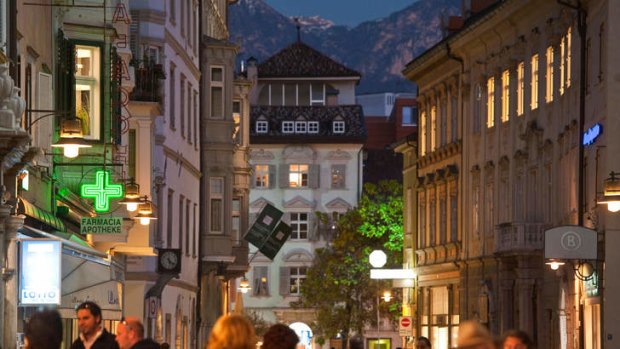
Bolzano's old town.Credit: Alamy
Michael Gebicki finds doppelgangers all around in an Italian city of distinctly Austrian flavour.
'Are we still in Italy?" The man on the platform at the station in Bolzano is perplexed, and I know what he means. So convincingly does Bolzano mirror the architecture, the language, the manners and the mores of Austria's nearby Tyrol region that it's all I can do to stop myself from answering "Ja!"
Located in Italy's most northerly province, Bolzano is the capital of South Tyrol, which the Italians know as the Alto Adige, the High Adige, after the river that gallops through its heart.
Until the end of the First World War this was Austrian territory, and Bolzano still prefers to think of itself as something other than true red, white and green Italian. German is the lingua franca, "Guten tag" the standard greeting.
Pasticcerie are konditorei here, and men in knickerbockers with alpenstocks and Tyrolean hats with feathers tucked into the band can sometimes be seen strolling through Bolzano's Piazza Erbe - Obstmarkt to the locals.
Even the name "Bolzano" has a doppelganger. To the German-speaking population, this is not Bolzano at all, but Bozen. And though you might find me in Waltherplatz enjoying a kaffee mit torte, to me this is lovely and lyrical "Bolzano", never "Bozen".
It's the towering peaks of the Dolomites surrounding the city that give the game away. Bolzano is the base for hiking, biking, skiing and mountaineering trips in some of Europe's most sensational alpine country. Most travellers who pass through Bolzano are looking for adventure, but it's well worth pausing here just to catch your breath and take in the sights.
Much of Bolzano's charm comes from its age. In the city centre, nothing much has been built since the late 19th century, and the cityscape is dominated by bell towers and church spires, the most impressive being the cathedral that sits under a decorative tiled roof at the city's mediaeval heart. The daily produce market brings life to the cobblestones of Piazza delle Erbe, where open-fronted stalls sell everything from strawberries to wines, speck and kaminwurzen, the local smoked sausage. Cafes spill across the cobblestones of Waltherplatz, and along Mustergasse is a series of baroque facades that were once the homes of the city's wealthiest merchants and bankers.
Poised photogenically on a sharp crag overlooking Bolzano is the 10th-century castle Sigmundskron, part of the Messner Mountain Museum created by local lad Reinhold Messner, one of the greatest mountaineers. In contrast to the stone walls of the thousand-year-old castle, the museum is a surprisingly modernist steel-and-glass construction furnished with symbolic objects, quotes and memorabilia from various mountaineering expeditions that explore the almost mystical relationship between mountains and the people who live there. If the museum proves inspirational, you can easily follow Messner's footsteps in modest fashion by taking the cable cars that hoist you from Bolzano to outstandingly luscious mountainsides.
The Colle Cable Car is the world's oldest funicular, built by a hotelier to haul guests up to his mountain lodge. The Renon Cable Car connects Bolzano with Soprabolzano, from where a historic narrow-gauge scenic railway completes the trip to the glorious Renon Plateau, through flowery meadows set against spiky peaks. At the top is a restaurant that plays jolly accordion music reminiscent of lederhosen and thigh-slapping dances.
No right-minded visitor would want to miss Otzi the Iceman. Housed in Bolzano's South Tyrol Museum of Archaeology, Otzi is the mummified corpse of a Stone Age man who lived in this region a little more than 5000 years ago. When he died from blood loss caused by an arrow wound his body was covered by snow and ice, which kept it in a remarkable state of preservation. The discovery of his body by two German hikers in 1991, in a rock gully filled with glacier melt, changed how we thought about Stone Age life.
From his copper-bladed axe to his first-aid kit, backpack, goat-hair leggings, shoes and bearskin cap, this was a man well adapted to living in the hostile environment in which his body was found, at an altitude of 3200 metres in the Otztal Alps.
The museum is mostly a reconstruction of Otzi's life and times. His corpse lies in a sealed, darkened room and can only be glimpsed through a tiny window.
It seems absolutely true to Bolzano's character that as I exit the museum I am almost taken out by a girl on a bike, dirndl skirt flying, with braided blonde hair, who looks as if she's just stepped off the set of The Sound of Music.
TRIP NOTES
GETTING THERE
Singapore Airlines has a fare to Milan for about $1820 low-season return from Sydney and Melbourne, including taxes. Fly to Singapore (about 8hr) and then to Milan (13hr 15min); see singaporeair.com; phone 13 10 11. There are frequent train services to Bolzano taking about three hours with a change in Verona.
STAYING THERE
The Hotel Greif is the city's best, stylish and in a premium location with 33 sculpted rooms accented with original artworks. Doubles from €158 ($222). See greif.it.
Gasthof Kohlern sits above Bolzano among pine forests and meadows. The world's oldest cable car links the guesthouse to Bolzano. From €130 for two a night. See kohlern.com.
Drei Birken is a small and wonderful guesthouse situated in the tiny village of Oberbozen. Cheapest rooms are small, so pay a modest premium for something larger. From €74 for two a night. See dreibirken.it.
TOURING THERE
A hire car is essential for anyone who wants to make the most of the region's adventure opportunities.
MORE INFORMATION
Sign up for the Traveller Deals newsletter
Get exclusive travel deals delivered straight to your inbox. Sign up now.